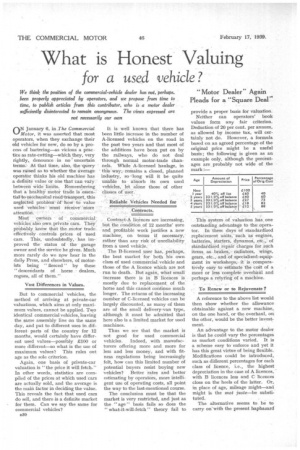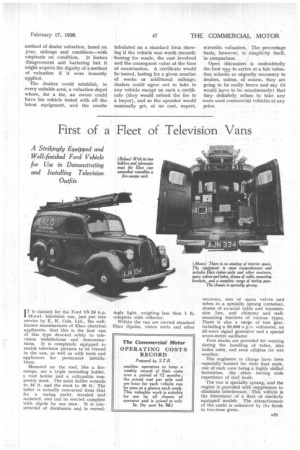What is Honest Valuing
Page 40

Page 41

If you've noticed an error in this article please click here to report it so we can fix it.
for a used vehicle?
ON January 6, in The Commercial Motor, it was asserted that most operators, when they exchange their
old vehicles for new, do so by a process of bartering—as vicious a prac tice as rate-cutting—which they, very rightly, denounce in no uncertain terins. At that time, also, the query
was raised as to whether the average operator thinks his old machine has a definite value or one that• can Vary between Wide limits. Remembering that a healthY motor trade is -esseti-:::
rOacl'tranSport, this neglected problem:df ho' to value used 'vehicles 'must receive More attentian.
Most 131,Vtiers of commercial vehicles also own private cars. They probably know that the motor trade.
effectively controls prices of used cars. This, undoubtedly, has im proved the status of the garage owner and the service he gives. Much more rarely do we now hear in the daily Press, and elsewhere, of motorists being " fleeced " by these " descendants of horse dealers, rogues, all of them."
Vast Differences in Values.
But to commercial 'vehicles, the method of arriving at private-car valuations, which aims at only maximum values, cannot be applied. Two identical commercial vehicles, leaving the same assembly line on the same day, and put to different uses in different parts of the country for 12 months, would certainly have different used values—possibly £100 or more different—so what is the use of maximum values? This rules out age as the sole criterion.
Again, one basis of private-car valuation is "the price it will fetch." In other words, statistics are compiled of the prices at which used cars are actually sold, and the average is the main factor in deciding the value. This reveals the fact that used cars do sell, and there is a definite market for them. Can we say the same for commercial vehicles?
B30 It is well known that there has been little increase in the number of A-licensed vehicles on the road in the past two years and that most of the additions have been put on by the railways, who do not deal through normal motor-trade channels. While A-licensed haulage, in this waye remains a closed, planned industry, so long will it be quite urib,ble to absorb its own used vehicles,' let alone those of other ,
clasSes of user.
, • Contract-A licences are increasing, ,
bit the condition of 12 months' sure and profitable work justifies a new machine, on terms if necessary, rather than any risk of unreliability. from a used vehicle.
The B-licensed user has, perhaps, the best market for both his own class of used commercial vehicle and those of the A licence which are not run to death. But again, what small increase there is in B licences is mostly due to replacement of the horse and this cannot continue much longer. The returns of the increasing number of C-licensed vehicles can be largely discounted, as many of them are of the small delivery-van type, although it must be admitted that here also is a limited market for used machines.
Thus we see that the market is not good for used commercial vehicles. Indeed, with manufacturers offering more and more for less and less money, and with fit ness regulations being increasingly felt, how can this limited number of potential buyers resist buying new vehicles? Better rates and better estimating by operators, more intelligent use of operating costs, all point the way to the last-mentioned course.
The conclusion must be that the market is very restricted, and just as the "age" basis fails so does the " what-it-will-fetch " theory fail to provide a proper basis for valuation.
Neither can operators' book values form any fair criterion. Deduction of 20 per cent. per annum, as allowed by income tax, will certainly not do. However, a formula based on an agreed percentage of the original price might be a useful basis; the following is given as an example only, although the percentages are probably not wide of the mark :— This system of valuation has one outstanding advantage to the operator. In these days Of standardized replacement units, such as engines, batteries, Starters, dynamoS, ett:, of standardiied repair charges for Such items, as brakes, radiators, wings, gears, etc., and of specialized eqnip
ment workshops,'. it is -comparatiVely easy to estimate the cot of a more or less complete overhatil and perhaps a retyring of a machine.
To Renew or to Rejuvenate ?
A reference to the above list would then show whether the allowance obtainable against a new machine, on the one hand, or the overhaul, on the other, would be the better investment.
An advantage to the motor dealer is that he could vary the percentages as market conditions varied. It is a scheme easy to enforce and yet it has this great virtue of being flexible. Modifications could be introduced, such as different percentages for each class of licence, i.e., the highest depreciation in the case of A licences, with B licences less and C licences close on the heels of the latter. Or, in place of age, mileage might—and might is the snot juste—be substituted.
The alternative seems to be to carry on -with the present haphazard
method of dealer valuation, based on year, mileage and condition—with emphasis on condition. It fosters disagreement and bartering but it might acquire the dignity of a method of valuation if it were honestly applied.
The dealers could establish, in every suitable area, a valuation depot where, for a fee, an owner could have his vehicle tested with all the latest equipment, and the results tabulated on a standard form showing if the vehicle was worth reconditioning for resale, the cost involved and the consequent value at the time of examination. A certificate would be issued, lasting for a given number of weeks or additional mileage; dealers could agree not to take in any vehicle except on such a certificate (they would refund the fee to a buyer), and so the operator would nominally get, at no cost, expert, scientific valuation. The percentage basis, however, is simplicity itself, in comparison.
Open discussion is undoubtedly the best way to arrive at a fair valuation scheme so urgently necessary to dealers, unless, of course, they are going to be really brave and say (it would have to be unanimously) that they definitely refuse to take any more used commercial vehicles at any price.




















































































